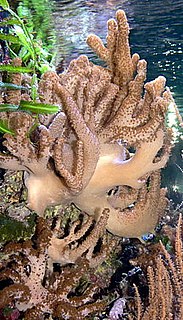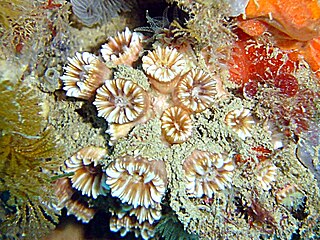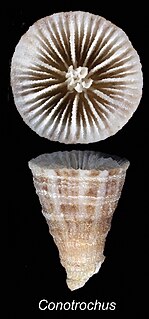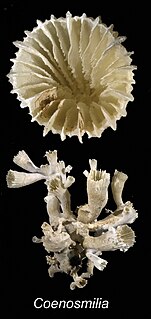
Scleractinia, also called stony corals or hard corals, are marine animals in the phylum Cnidaria that build themselves a hard skeleton. The individual animals are known as polyps and have a cylindrical body crowned by an oral disc in which a mouth is fringed with tentacles. Although some species are solitary, most are colonial. The founding polyp settles and starts to secrete calcium carbonate to protect its soft body. Solitary corals can be as much as 25 cm (10 in) across but in colonial species the polyps are usually only a few millimetres in diameter. These polyps reproduce asexually by budding, but remain attached to each other, forming a multi-polyp colony of clones with a common skeleton, which may be up to several metres in diameter or height according to species.

Madrepora is a genus of stony corals, often found forming reefs or islands in tropical locations. The names Madrepore and Madreporaria were formerly applied universally to any stony coral of the family Scleractinia. They reproduce in three separate ways as discovered by the marine zoologist Anne Thynne (1800-1866). It is commonly known as horn coral. colony is branched with small polyps in cylindrical cups separated by perforated coenosteum. Terminal polyp bear six tentacles, while lateral polyps bear twelve tentacles. Madrepora is economically important because it takes part in the formation of coral reefs.

Alcyonacea, or soft corals, are an order of corals. In addition to the fleshy soft corals, the order Alcyonacea now contains all species previously known as "gorgonian corals", that produce a more or less hard skeleton, though quite different from "true" corals (Scleractinia). These can be found in suborders Holaxonia, Scleraxonia, and Stolonifera. They are sessile colonial cnidarians that are found throughout the oceans of the world, especially in the deep sea, polar waters, tropics and subtropics. Common names for subsets of this order are sea fans and sea whips; others are similar to the sea pens of related order Pennatulacea. Individual tiny polyps form colonies that are normally erect, flattened, branching, and reminiscent of a fan. Others may be whiplike, bushy, or even encrusting. A colony can be several feet high and across, but only a few inches thick. They may be brightly coloured, often purple, red, or yellow. Photosynthetic gorgonians can be successfully kept in captive aquaria.

The Caryophylliidae are a family of stony corals found from the tropics to temperate seas, and from shallow to very deep water.

Astreopora is a genus of stony corals in the Acroporidae family. Members of the genus are commonly known as star corals and there are seventeen species currently recognized.

Frontonia is a genus of free-living unicellular ciliate protists, belonging to the order Peniculida. As Peniculids, the Frontonia are closely related to members of the genus Paramecium. However, whereas Paramecia are mainly bacterivores, Frontonia are capable of ingesting large prey such as diatoms, filamentous algae, testate amoebas, and even, in some circumstances, members of their own species. In bacteria-rich saprobic conditions, Frontonia leucas can live as a facultative bacterivore.

Cycloseris is a genus of solitary disc corals in the family Fungiidae. They are found in the Indo-Pacific. They inhabit the lower reef slopes, and the areas between reefs with soft sediments. They tolerate turbid waters.

Balanophyllia is a genus of solitary corals in the order of stony corals.
Corallimorphus profundus is a species of corals in the genus Corallimorphus. It lives in marine habitats. This species can be found in the Southern Ocean and in New Zealand.

Turbinaria is a genus of colonial stony corals in the family Dendrophylliidae. Common names for this genus include disc coral, scroll coral, cup coral, vase coral, pagoda coral and ruffled ridge coral. These corals are native to the Red Sea, Indian Ocean, Japan and the south Central Pacific Ocean.

Dactylotrochus is a genus of large polyp stony corals from the Red Sea and western Pacific Ocean. It is monotypic with a single species, Dactylotrochus cervicornis. It inhabits the deep sea and is believed to be azooxanthellate.

Schizocyathus is a monotypic genus of stony corals in the family Schizocyathidae, the only species being Schizocyathus fissilis. It is a deep water, azooxanthellate coral.

Conotrochus is a genus of small corals in the family Caryophylliidae. It holds four species.

Colangia is a genus of small corals in the family Caryophylliidae.

Coenosmilia is a genus of small corals in the family Caryophylliidae.

Dasmosmilia is a genus of small corals in the family Caryophylliidae.

Oxypora glabra is a species of large polyp stony coral in the family Lobophylliidae. It is a colonial coral with thin encrusting laminae. It is native to the central Indo-Pacific.

Leptastrea is a genus of massive reef building stony corals known primarily from the Indo-Pacific. Although previously assigned to Faviidae, Budd et al. (2012) assigned it to Scleractinia incertae sedis based on phylogenetic results demonstrating the polyphyly of Faviidae.

Heterocyathus is a genus of coral of the family Caryophylliidae.
Tubastraea tagusensis is a hard coral species in the family Dendrophylliidae. The species is azooxanthellate, thus does not need sunlight for development, and does not form reefs. It is native to the Galapagos Islands but has become invasive along the Atlantic coast of South America.



















